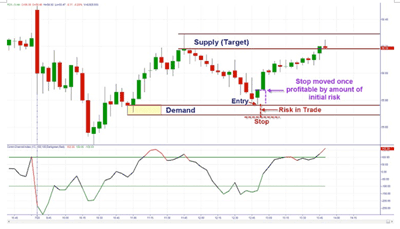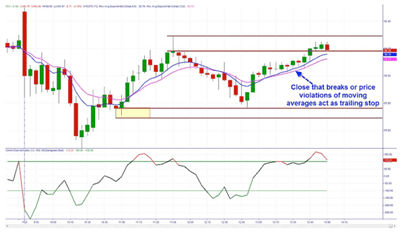One trader describes how to effectively place and manage a stop-loss order to protect hard-earned profits as the trade unfolds but avoid being shaken out before the profit target is reached.
I love receiving e-mail questions from students. It keeps me sharp and also lets me know that they are actively participating in their trading education. A recent e-mail was inquiring about the proper use of stop-market orders versus trailing stops in trades.
I want to first reiterate that there is no one way to trade. That is what makes this so challenging and fun. We need to find a style that best suits us and create rules that we can follow and improve upon.
For my own trading, I will start by placing a stop-market order at the place where the markets would prove me wrong in my trade. For longs, that is an area below the demand zone where I buy. In a short position, I place that stop above the supply zone that allowed me to go short. By placing my stops in those places, I am only likely to be stopped out due to market conditions changing, rather than normal fluctuations of the security.
In every trade, I know a minimum of three things before placing the trade. I know my entry, my target, and my stop. This knowledge removes emotions such as fear and greed from my trading and allows me to focus on price action. It also gives me direction for managing the trade. There is a saying in trading, "Once green, never red!"
This means that once you are profitable in a trade, you shouldn't give back those profits and turn a winner into a loser. To me, this means I must adjust my stops to protect those profits.
I don't consider myself profitable in the trade as soon as the trade goes into the green. I wait until I have profit in the trade that is equal to the amount I was willing to risk initially in that trade; the amount between the entry and stop price. Once that occurs, I will move my stop to breakeven so as not to go red after profiting.
Once that happens, I will then use one of a few rule-based strategies for protecting future profits and moving my stop with the trade. It could be a moving average, a trend line, volatility stop, or swing lows or highs. There is no one perfect stop; the key is to be consistent and rule based.
So, when do I use trailing stops? I don't usually. I am typically setting manual stop-market orders or automating the stops through TradeStation based on a technical stop. Trailing stops are great for traders who are not available to watch their positions or change stops when required. They are fortunate to have the computer do it for them with the use of a trailing stop.
The problem with the trailing stops is market volatility. A quick swing in your favor could cause a spike in profit and adjust your trailing stop too tight. When price returns to the normal trend, you may find that you were shaken out before your profit target was reached.
I am not saying you shouldn't use trailing stops. Just be aware of all the advantages and disadvantages of the tools available to you and create your trading rules based on what fits your style the best.
Happy trading, and may all your trades be green and your losses small.
By Brandon Wendell, instructor, Online Trading Academy























